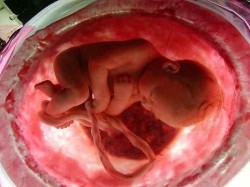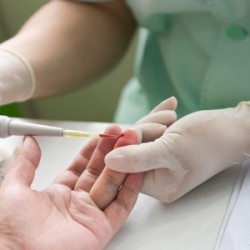Placenta and its functions

The placenta plays an important role in the life of the fetus. Through it, the child receives oxygen required for life nutrients and mothers Mom.
You can select multiple important functions that perform placenta:
- Supposes the fruit with oxygen through the blood of the mother and remove carbon dioxide. The slightest detachment of the placenta threatens the baby with a lack of oxygen;
- Through the placenta, the child receives all nutrients, vitamins, trace elements and liquid;
- In the placenta, it is developed very important to ensure the pregnancy of hormones - prolactin, prozterone, hCG, placental lactogen;
- The placenta supplies the fruit of the Mom antibodies, thereby providing the baby immunological protection against infections.
The degree of detachment of the placenta

- In the early period of pregnancy throughout 1 trimester, the discontinuation of the placenta occurs more often. If you diagnose pathology on time, start the appropriate treatment, then a lot of chances remain on pregnancy. The placenta still has time to compensate for the lagging place from the uterus with the growth of its area. It is for this reason that obstetrician gynecologists recommend pregnant to get into account as soon as possible so as not to miss the pathology.
- In 2 trimester of pregnancy, the detachment of the child's place is accompanied by a high tone of the uterus. But in this case, timely treatment will help preserve pregnancy, and the growing placenta will be able to compensate for its losses, continuing to grow.
- In 3 trimester, the disclosure of the placenta is considered the most dangerous, because the child's place is already nowhere to grow, and there is no way to compensate for their losses. On this period, there is a hypertonus of uterus with pain, abundant bleeding. Future is observed Hypoxia and heartfelt violation.
- Another dangerous pathology - detachment of the placenta in 1 or 2 period of birth. In this case, doctors make a decision to stimulate childbirth or cesarean section.
Diagnosis of pathology
If the discontinuation of the placenta is not accompanied by strong pain or bleeding, the diagnosis put the method of excluding other pathologies. To do this, use an ultrasound examination apparatus that will show the degree of detachment.
Causes of placenta detachable

Even with normally proceeding pregnancy, the placenta may occur and this happens for the following reasons:
- One of the causes of pathology may be a problem with blood vessels in diseases of the cardiovascular system, Hypertension, Pyelonephritis, Sugar diabetes. In this case, the vessels become fragile and incapable of passing enough blood through itself.
- With some gynecological diseases there is a threat to premature discontinuation of the placenta - when Moma or fibromic uterus.
- In the placenta itself, inflammatory processes of degenerative nature may be observed, which lead to detachment.
- With some autoimmune diseases there is a threat to the discontinuation of the placenta. One of them is the red lupus, in which the body produces antibodies to its own cells, destroying them.
- With the wrong lifestyle, the pregnancy of women can also be threatened. Alcohol Abuse, Smoking, Narcotic Dependency - All this can lead to peeling placenta up to miscarriage.
- Reduced hemoglobin may be one of the causes of pathology.
- Gestosis in late pregnancy can be the reason for the detachment of the placenta.
- Allergic response to some medicines can lead to the disclosure of the placenta. Most often, such a reaction is observed when blood transfusion or when it is introduced, it is allergic or rejection.
- Stress, depression, nervous disorders, abdominal injuries in accidents or fall - all this can lead to a threat of miscarriage due to the detachment of the placenta.
- Re-pregnancy earlier than a year after previous births may result in this pathology. Gynecologists recommend to take a break between pregnancies at least 1-2 years. This time is enough to restore the forces of the future mother, then pregnancy will proceed without complications.
Treatment when detretation of the placenta

The doctor makes a decision to choose treatment depending on the following factors:
- From when a detachment takes place - during the pregnancy itself or already during childbirth;
- from the abundance of bleeding;
- from the state of pregnant and fetus.
For pregnancy, the following drugs are used to maintain pregnancy:
- Mattering spasms (But-shp, Papaverine, Metacin, Magnesia). Prescribed in the form of candles, intramuscular injections, in the form of droppers or tablets;
- Relaxing drugs (Fenoterol, Duvadilan, Salbapart);
- Preparations, stopping bleeding (vikasol, dicinon, calcium chloride);
- Tools for increasing hemoglobin (iron-containing drugs). With a slightly reduced hemoglobin, a diet is appointed, in which there are products rich in iron - red meat, fish, apples, caviar, beets, buckwheat.
On a period of 36 weeks, with the detachment of the placenta, depending on the degree of pathology, doctors may decide to stimulate childbirth or about the operational delivery (cesarean section). In other cases, in addition to drug treatment, the doctor gives the following recommendations:
- Any physical exertion is prohibited by the future mom, bed rests.
- Doctors are watching a state of a woman in a hospital.
- Pregnant woman prescribe an ultrasound examination, dopplerometry, cardiotokography, blood tests for clotting.
Prevention of pathologies

Every woman dreaming to endure and give birth to a healthy child should prepare for pregnancy:
- Touch the gynecologist. The doctor will appoint blood tests and ultrasound to identify infections and diseases that can be a threat to the health of the future mother and baby. If necessary, drug treatment and reception of multivitamin complexes will be appointed.
- In addition, a woman needs to visit such specialists as a cardiologist, an endocrinologist, an ophthalmologist, an allergist and in some cases a nutritionist. Doctors will examine the future mother and will exclude or confirm the presence of diseases that may cause pathology.
- Woman during pregnancy planning should lead a healthy lifestyle. If you smoke or abuse alcohol, you need to get rid of these detrimental habits.
The future mother should understand that the disclosure of the placenta is a big threat to the life of the child and for her own life. MirSees recommends with any signs and symptoms testifying to this pathology, urgently apply to the doctor.









